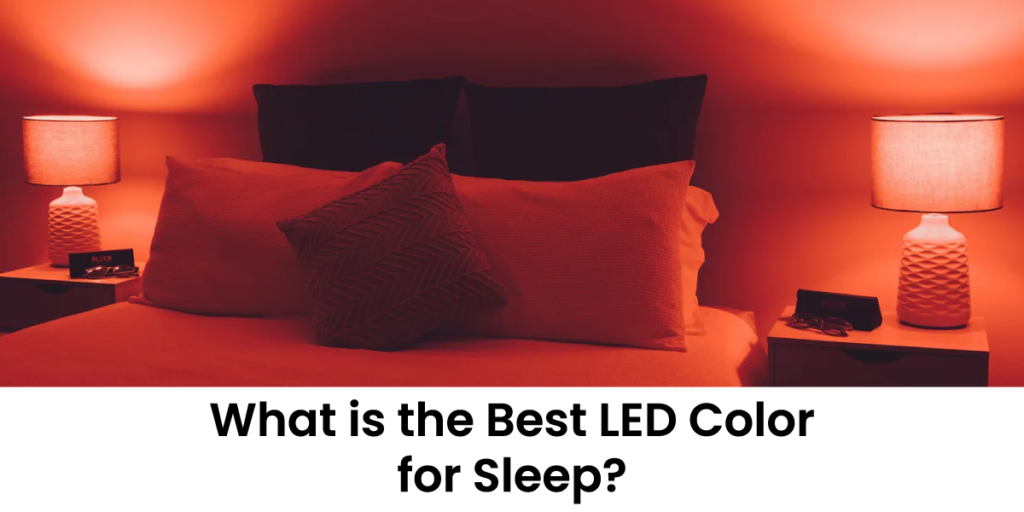Struggling to Get a Good Night’s Sleep?
Let’s say you’re lying in bed, tossing and turning, and staring at the ceiling. It feels like sleep is miles away. Ever thought your bedroom lights might be the reason?
Here’s the truth: The color of your LED lights can make a huge difference in how fast you can fall asleep and how deeply you rest. Some lights help your brain relax, while others trick it into staying awake.
In this blog, we’ll show you exactly what is the best led color for sleep, why it works, and how you can use it to create the perfect bedtime vibe.
Let’s make falling asleep easier for you—starting tonight!
Why LED Colors Affect Sleep

Light plays a big role in how your brain and body get ready for bed. It works with something called your circadian rhythm. This is your body’s internal clock that tells you when to sleep and when to wake up.
Some lights can mess up this natural clock. For example:
- Blue light from screens or bright white bulbs tells your brain, “It’s daytime! Stay awake!”
- Other colors, like red or orange, say, “It’s nighttime! Time to relax and sleep.”
Your light choice can either help you sleep better or keep you awake longer.
Let’s look at how different colors work.
How Light Affects Melatonin
Melatonin is the hormone that makes you feel sleepy. Your body produces it when it gets dark. But certain lights can reduce melatonin production,which makes it hard to fall asleep.
Here’s a simple chart that shows how colors impact melatonin:
| Light Color | Melatonin Impact | How It Feels |
| Red | Minimal disruption | Calm and relaxing |
| Orange | Slight disruption | Cozy and warm |
| Warm White | Moderate disruption | Neutral, soft |
| Cool White | High disruption | Bright and alert |
| Blue | Very high disruption | Energizing, stimulating |
So, What is the Best LED Color for Sleep?

Red is the best led color for sleep because it doesn’t interfere with melatonin.
So, Why Red LED Light Is the Best for Sleep
Red light is amazing for your bedroom. Here’s why:
- It mimics natural light at sunset. Your brain sees red light and thinks it’s nighttime, which makes it easier to relax.
- It has a low wavelength. This means it doesn’t mess with melatonin, unlike blue or white lights.
Benefits of Using Red Light at Night
- Helps you fall asleep faster.
- Improves sleep quality.
- Reduces eye strain and makes your room feel cozy.
- Gives your room a romantic vibe.
How to Use Red Light in Your Bedroom
Using red light in your bedroom is super easy, and it can make a big difference in helping you relax before bed.
Start with LED strips. You can stick them around your bed frame, behind your headboard, or even along the ceiling edges. They create a soft, calming glow without being too bright.
Another great idea is to use red bedside lamps. These are perfect if you like to read or unwind before sleeping, as they won’t strain your eyes or mess with your melatonin levels.
If you prefer something more modern, try a smart red bulb. These bulbs let you dim the light gradually so you can lower the brightness as you get closer to bedtime. It’s like telling your brain, “Hey, it’s time to wind down!”
Simple adjustments like these can create a cozy, sleep-friendly space in no time.
What About Other Colors?
Red might be the best, but other colors can work too. Let’s compare:
| Color | Good for Sleep? | Why or Why Not? |
| Orange | Yes, but not as good as red | Close to red wavelength. Slightly more stimulating. |
| Warm White | Okay, but not ideal | Softer than cool white. Still disrupts melatonin a bit. |
| Pink | Yes, but mainly aesthetic | Calming and fun for kids’ rooms. Similar to red in effect. |
| Green | Neutral | Doesn’t disrupt sleep but doesn’t promote it either. |
| Blue/Cool White | No | Stops melatonin production. Makes your brain feel alert. |
So, at this point, if you’re wondering what color LED lights help with sleep, red is the clear winner. Orange and pink are decent backups.
How to Choose the Right LED Lights for Sleep

Let’s make it easy for you. Follow these tips:
- Go for dimmable red or orange lights. This lets you adjust the brightness for a cozy vibe.
- Avoid lights with blue tones. Look for “warm” or “soft white” on the packaging.
- Check the color temperature. Pick LEDs with 2000–3000 Kelvin (K). Lower Kelvin numbers are warmer and better for sleep.
Setting Up Your Perfect Sleep Space
Want your bedroom to feel like a sleep haven? Here’s how:
- Use red LED strips: Place them behind your bed or along the ceiling for a soft glow.
- Add a red bedside lamp: Perfect for nighttime reading.
- Pair lights with blackout curtains: Block outside light for total darkness.
- Install smart bulbs: These let you change colors and dim the lights using your phone.
Myths About LED Colors and Sleep

Let’s clear up some common myths about LED colors and sleep because not all “warm” lights are as sleep-friendly as they seem.
Many people think any warm light, like soft white or orange, is good for bedtime, but that’s not always true. For example, warm white lights might look cozy, but they still have traces of blue light. That blue light can mess with your melatonin, the hormone your body needs to feel sleepy.
Even pink or orange lights aren’t automatically perfect for sleep unless they’re very dim and low in brightness. This is where the red light stands out. It’s not just about how nice it looks—it’s backed by science!
Red light has a low wavelength, which means it doesn’t disrupt your body’s natural rhythm. It helps your brain relax and tells your body it’s time to sleep. So, if you want to avoid mistakes, stick with red for the best results.
Wrapping Up
If you’re looking for the most relaxing light color for sleep, red is the best led color for sleep. It’s gentle on your eyes, doesn’t mess with melatonin, and helps your brain prepare for rest. But if red isn’t your style, you can try orange or pink as alternatives. Just remember to avoid blue and white lights, especially before bedtime.
If you’re looking for the perfect way to set a romantic mood, the Love Lamp is for you. Its soft red glow creates a cozy, sensual atmosphere for you and your partner. It’s simple to use—just one tap, no apps or hassle. Plus, it’s discreet, durable, and comes with a 30-day money-back guarantee!
So, why not give it a try? Switch to red LED lights tonight and see how much better you sleep!
FAQs
- Is red light safe to sleep with?
Yes, red light is safe to sleep with. It doesn’t block melatonin like blue light does, so it won’t mess up your sleep. In fact, it can even help you sleep better by relaxing your body and mind.
- Can red LED light help with insomnia?
Yes, red LED light can help with insomnia. It boosts melatonin, relaxes your body, and calms your nervous system, making it easier to fall asleep. Studies even show it helps people sleep faster and wake up less during the night.
- What’s the difference between red and orange LED lights for sleep?
Red is better because it’s closer to sunset hues. Orange is still good but slightly more stimulating.
- What color light is best for sleeping?
Red is the best, followed by orange and pink.

